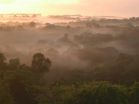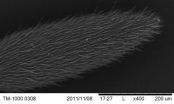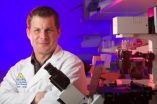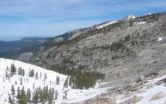(Press-News.org) It's morning, deep in the Amazon jungle. In the still air innumerable leaves glisten with moisture, and fog drifts through the trees. As the sun rises, clouds appear and float across the forest canopy ... but where do they come from? Water vapor needs solid surfaces to condense on. Airborne particles are the seeds of liquid droplets in fog, mist, and clouds.
To learn how aerosol particles form in the Amazon, Mary Gilles of the Chemical Sciences Division at the U.S. Department of Energy's Lawrence Berkeley National Laboratory (Berkeley Lab) and David Kilcoyne of the Lab's Advanced Light Source (ALS) worked with Christopher Pöhlker of Germany's Max Planck Institute for Chemistry (MPIC) as part of an international team of scientists led by MPIC's Meinrat Andreae and Ulrich Pöschl. They analyzed samples of naturally formed aerosols collected above the forest floor, deep in the rainforest.
Combined with results from other facilities, the ALS analysis provided essential clues to the evolution of fine particles around which Amazon clouds and fog condense, beginning with chemicals produced by living organisms. The team found that among the most important initial triggers of the process are potassium salts.
Dissecting invisible aerosols
At ALS beamline 5.3.3.2, the researchers performed scanning transmission x-ray microscopy (STXM) to determine the near-edge x-ray absorption fine structure (NEXAFS) of particles collected during the wet season in the remote, pristine forest northeast of Manaus, Brazil.
"Through absorption of soft x-rays by an atom's core electrons, and subsequent emission of photons, the identity and exact location of the elements in the aerosol samples can be identified," says Kilcoyne. "The essence of STXM is that it not only tells you if carbon is present but how this carbon is bound to other elements within the aerosol particles. This allows us to distinguish between soot, which is graphitic, and organic carbon."
The researchers found three different types of organic aerosol particles, all similar to laboratory-generated reference samples: oxidation products based on precursor chemicals emitted in the gas phase by trees, including terpenes (the major component of turpentine) from tree resin, and isoprene, another organic compound abundantly released through leaves.
"In the beginning we focused on the carbon, oxygen, and nitrogen contents of the organic materials," says Pöhlker. "But then, to our surprise, we found very high potassium levels, up to 20 percent." The 77 Amazonian aerosol samples were remarkable for the strong signal of potassium, in the form of salts, in all but three of them.
The samples were on the scale of mere millionths or billionths of a meter. The smaller the aerosol, the greater the proportion of potassium – those collected early in the morning were the smallest and richest in potassium. Larger particles contained more organic material but not more potassium. These facts suggest that potassium salts generated during the night acted as seeds for gas-phase products to condense onto, forming aerosols of different kinds.
"Biomass burning is also a rich source for potassium-containing aerosols in forested regions, but potassium from forest fires is correlated with the presence of soot, a graphitic form of carbon," Gilles says. "Before and during the collection period there were no documented fires that could have affected the biosphere where the samples were collected, and no evidence of soot was observed in the samples. Hence the source of potassium could only have been natural forest organisms."
Prime suspect
Fungal spores in the larger aerosol samples pointed to the prime suspect. Some fungi launch spores by building up water pressure through osmosis in sacs (asci) that contain the spores; when the pressure is great enough, the ascus bursts and squirts the spores into the air, along with fluid containing potassium, chloride, and sugar alcohol. Other fungi fire "ballistospores" when water vapor in the atmospheres condenses and causes a sudden release of restraining surface tension, also ejecting potassium, sodium, phosphates, sugars, and sugar alcohol.
Other biogenic mechanisms also release salts into the early morning mists that cover the forest, including salts dissolved in water by transpiration during the day and, at night, the oozing of sap rich in sugars, minerals, and potassium from the edges of leaves.
Thus invisibly tiny grains of potassium salts, generated by natural plants and other living things at night and early in the morning, play a key role in the formation of aerosols in the rainforest.
Terpenes and isoprenes are primarily released in the gas phase by plants in the jungle, and once in the atmosphere they react with water, oxygen, and organic, compounds, acids, and other chemicals exuded by indigenous plants. These reaction products are less volatile and initiate the condensation within the low-lying forest biosphere. Since the smallest particles are typically the most important in condensation, potassium salts fill the role. As the day goes on, organic gas-phase products continue to condense and the particles continue to grow.
Throughout the rainy season the cloud cover, precipitation, water cycle, and finally the climate of the Amazon basin and beyond can be traced back to salts from fungi and other plants in the undisturbed jungle, providing the precursors of natural cloud-condensation nuclei and directly influencing how fog and clouds form and evolve in the rainforest.
INFORMATION:
"Biogenic potassium salt particles as seeds for secondary organic aerosol in the Amazon," by Christopher Pöhlker, Kenia T. Wiedemann, Bärbel Sinha, Manabu Shiraiwa, Sachin S. Gunthe, Mackenzie Smith, Hang Su, Paulo Artaxo, Qi Chen, Yafang Cheng, Wolfgang Elbert, Mary K. Gilles, Arthur L. D. Kilcoyne, Ryan C. Moffet, Markus Weigand, Scot T. Martin, Ulrich Pöschl, and Meinrat O. Andreae, appears in the August 31, 2012 issue of Science and is available online at http://www.sciencemag.org/content/337/6098/1075.abstract.
The Max Planck Institute for Chemistry's press release on this research is at http://www.mpg.de/6329380/plants_fungi_salt-aerosol. Work at the Advanced Light Source was supported by DOE's Office of Science.
Lawrence Berkeley National Laboratory addresses the world's most urgent scientific challenges by advancing sustainable energy, protecting human health, creating new materials, and revealing the origin and fate of the universe. Founded in 1931, Berkeley Lab's scientific expertise has been recognized with 13 Nobel prizes. The University of California manages Berkeley Lab for the U.S. Department of Energy's Office of Science. For more, visit www.lbl.gov.
The Advanced Light Source is a third-generation synchrotron light source producing light in the x-ray region of the spectrum that is a billion times brighter than the sun. A DOE national user facility, the ALS attracts scientists from around the world and supports its users in doing outstanding science in a safe environment. For more information visit www-als.lbl.gov/.
DOE's Office of Science is the single largest supporter of basic research in the physical sciences in the United States, and is working to address some of the most pressing challenges of our time. For more information, please visit the Office of Science website at science.energy.gov/.
Salt seeds clouds in the Amazon rainforest
Berkeley Lab scientists at the Advanced Light Source help track down the sources of condensation nuclei for mist and clouds in the Amazon rainforest
2012-09-11
ELSE PRESS RELEASES FROM THIS DATE:
UF researchers name new cusk-eels useful for understanding environment
2012-09-11
GAINESVILLE, Fla. -- A study by University of Florida and University of Kansas researchers describing eight new cusk-eel species provides data for better understanding how disasters like the 2010 Gulf of Mexico oil spill impact biodiversity and the environment.
The 60-year study appearing Tuesday in the Florida Museum of Natural History Bulletin provides a comprehensive taxonomic revision of one of the least-studied groups of cusk-eels, bony fishes distantly related to cod. Although abundant and widespread in the Americas, the fishes in the genus Lepophidium have previously ...
GEN reports on ocular therapeutics targeting the retina
2012-09-11
New Rochelle, NY, September 10, 2012-- Therapies for retinal diseases are expected to overtake those for glaucoma by 2014, reports Genetic Engineering & Biotechnology News (GEN). Because current retinal disease treatments only improve vision for six to eight weeks, there is a critical need for new remedies, according to a recent issue of GEN.
"As increasing numbers of baby-boomers continue to grow older, many will have to deal with eye diseases such as age-related macular degeneration," said John Sterling, Editor-in-Chief of GEN. "Some estimates put the current AMD and ...
Pain drug can kill resistant tuberculosis
2012-09-11
NEW YORK (September 10, 2012) -- An off-patent anti-inflammatory drug that costs around two cents for a daily dose in developing countries has been found by researchers at Weill Cornell Medical College to kill both replicating and non-replicating drug resistant tuberculosis in the laboratory -- a feat few currently approved TB drugs can do, and resistance to those is spreading.
Their findings, published online by the journal PNAS, point to a potential new therapy for the more than 500,000 people worldwide whose TB has become resistant to standard drug treatments. But ...
Rhode Island Hospital study shows wine has more cardiovascular benefits than vodka
2012-09-11
PROVIDENCE, R.I. – The next time you call someone a drunken pig, remember this study. Rhode Island Hospital researcher Frank Sellke, M.D., chief of cardiothoracic surgery at Rhode Island and The Miriam hospitals, and his colleagues studied the effects of red wine and vodka on pigs with high cholesterol and found that the pigs with a penchant for pinot noir fared better than their vodka swilling swine counterparts. The paper is published in the September issue of the journal Circulation.
"There has been previous research touting the benefits of moderate consumption of ...
Ants have an exceptionally 'hi-def' sense of smell
2012-09-11
Ants have four to five times more odor receptors than most other insects, a team of researchers have discovered.
The research team, led by Lawrence Zwiebel at Vanderbilt, recently completed the first full map of olfactory system that provides ants with their sense of taste and smell. They found the industrious insects have genes that make about 400 distinct odorant receptors, special proteins that detect different odors. By comparison, silk moths have 52, fruit flies have 61, mosquitoes range from 74 to 158 and honeybees have 174.
"The most exciting moment for me was ...
Researchers find 2 gene mutations drive adrenal cancer
2012-09-11
This press release is available in Portuguese.
ANN ARBOR, Mich. — Two different genetic mutations cooperate to induce adrenal cancer, according to a new study from researchers at the University of Michigan Comprehensive Cancer Center and University of Sao Paulo in Brazil.
The finding provides new clues to this rare and deadly cancer type, and researchers hope it will lead to better treatments by targeting both mutations.
About 600 Americans are diagnosed with adrenal cancer per year. It is typically diagnosed in late stages when there is nearly no chance of survival ...
CWRU nurse researchers find effort takes its toll on unpaid family caregivers
2012-09-11
According to AARP, the annual cost of unpaid elder caregiving – work that falls mainly on the backs of family members – runs about $450 billion.
While some companies document the physical and emotional toll that the workplace takes on their employees, exactly how draining caregiving might be has never really been measured.
So Case Western Reserve University nurse researchers studied it.
"Without knowing the impact of effort, we have two vulnerable people at risk for health issues—the caregiver and the care receiver," said Evanne Juratovac, assistant professor at ...
'Civilian cyber-warriors' not driven by patriotism
2012-09-11
EAST LANSING, Mich. -- People who commit cyber-attacks against the government also tend to download music illegally and participate in physical protests. Surprisingly, however, they don't appear to be acting out of some sense of national pride or patriotism.
Those are some of the findings to emerge from a Michigan State University study that for the first time begins to paint a profile of "civilian cyber-warriors," or people who engage in attacks against domestic or foreign governments. Cybercrimes pose a huge societal risk and have become a hot issue globally, yet little ...
Study ties forest 'greenness' in western US to snowpack extent
2012-09-11
Results of a new study tie forest "greenness" in the western United States to fluctuating year-to-year snowpack extent.
The results show that mid-elevation mountain ecosystems are the most sensitive to rising temperatures and to changes in precipitation and snowmelt.
University of Colorado-Boulder scientist Noah Molotch and colleagues used satellite images and ground measurements to identify the threshold at which mid-level forests sustained by moisture change to higher-elevation forests sustained by sunlight.
A paper reporting the results was published yesterday ...
NASA catches Tropical Storm Leslie and Hurricane Michael in the Atlantic
2012-09-11
Satellite images from two NASA satellites were combined to create a full picture of Tropical Storm Leslie and Hurricane Michael spinning in the Atlantic Ocean. Imagery from NASA's Aqua and Terra satellites showed Leslie now past Bermuda and Michael in the north central Atlantic, and Leslie is much larger than the smaller, more powerful Michael.
Images of each storm were taken by the Moderate Resolution Imaging Spectroradiometer, or MODIS instrument that flies onboard both the Aqua and Terra satellites. Both satellites captured images of both storms on Sept. 7 and Sept. ...
LAST 30 PRESS RELEASES:
University of Phoenix College of Doctoral Studies releases white paper on AI-driven skilling to reduce burnout and restore worker autonomy
AIs fail at the game of visual “telephone”
The levers for a sustainable food system
Potential changes in US homelessness by ending federal support for housing first programs
Vulnerability of large language models to prompt injection when providing medical advice
Researchers develop new system for high-energy-density, long-life, multi-electron transfer bromine-based flow batteries
Ending federal support for housing first programs could increase U.S. homelessness by 5% in one year, new JAMA study finds
New research uncovers molecular ‘safety switch’ shielding cancers from immune attack
Bacteria resisting viral infection can still sink carbon to ocean floor
Younger biological age may increase depression risk in older women during COVID-19
Bharat Innovates 2026 National Basecamp Showcases India’s Most Promising Deep-Tech Ventures
Here’s what determines whether your income level rises or falls
SCIE indexation achievement: Celebrate with Space: Science & Technology
Children’s Hospital Colorado performs region’s first pediatric heart and liver dual organ transplant
Australian team discover why quantum computers have memory problems over time
What determines the fate of a T cell?
Candida auris: genetic process revealed which could be treatment target for deadly fungal disease
Groundbreaking discovery turns household plastic recycling into anti-cancer medication
Blocking a key inflammatory pathway improves liver structure and vascular function in cirrhosis, study finds
Continuous spread: Raccoon roundworm detected in nine European countries
HKUST Engineering researchers developed a novel photodetector to enhance the performance of on-chip light monitoring
Strategic river sensors could have forewarned of Texas Camp flood disaster
Drone sampling of whale breath reveals first evidence of potentially deadly virus in Arctic
Roman soldiers defending Hadrian’s Wall infected by parasites, study finds
Pinochet’s prisoners were tormented with music but still found solace in it, a new book reveals
Fertility remains high in rural Tanzania despite access to family planning
AI-assisted device can improve autism care access
Kinetic careers
Uncovering how parasitic plants avoid attacking themselves to improve crop resistance
Nanoparticle vaccine strategy could protect against Ebola and other deadly filoviruses
[Press-News.org] Salt seeds clouds in the Amazon rainforestBerkeley Lab scientists at the Advanced Light Source help track down the sources of condensation nuclei for mist and clouds in the Amazon rainforest






